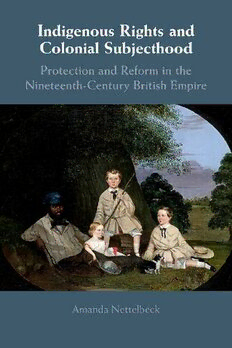
Indigenous Rights and Colonial Subjecthood: Protection and Reform in the Nineteenth-Century British Empire PDF
Preview Indigenous Rights and Colonial Subjecthood: Protection and Reform in the Nineteenth-Century British Empire
Indigenous Rights and Colonial Subjecthood AmandaNettelbeckexploreshowpoliciesdesignedtoprotectthecivil rights of indigenous peoples across the British Empire were entwined with reforming them as governable colonial subjects. The nineteenth- century policy of ‘Aboriginal protection’ has usually been seen as a fleetinginitiativeofimperialhumanitarianism,yetitsatwithinalarger set of legally empowered policies for regulating new or newly mobile colonised peoples. Protection policies drew colonised peoples within theembraceofthelaw,managedcoloniallabourneeds,andsetcondi- tionsonmobility.Withinthiscomparativeframe,Nettelbecktraceshow the imperative to protect indigenous rights represented more than an obligation to mitigate the impacts of colonialism and dispossession. It carriedafar-reachingagendaoflegalreformthatarosefromtheneedto managecolonisedpeoplesinanEmpirewherethedemandsofhumane governancejostledwithcolonialgrowth. amanda nettelbeck is Professor in the Department of History at the University of Adelaide and a Fellow of the Australian Academy of the Humanities. Her recent publications include Intimacies of Violence in the Settler Colony, co-edited with Penelope Edmonds, and Violence, ColonialismandEmpireintheModernWorld,co-editedwithPhilipDwyer. Indigenous Rights and Colonial Subjecthood Protection and Reform in the Nineteenth-Century British Empire Amanda Nettelbeck UniversityofAdelaide UniversityPrintingHouse,CambridgeCB28BS,UnitedKingdom OneLibertyPlaza,20thFloor,NewYork,NY10006,USA 477WilliamstownRoad,PortMelbourne,VIC3207,Australia 314–321,3rdFloor,Plot3,SplendorForum,JasolaDistrictCentre, NewDelhi–110025,India 79AnsonRoad,#06–04/06,Singapore079906 CambridgeUniversityPressispartoftheUniversityofCambridge. ItfurtherstheUniversity’smissionbydisseminatingknowledgeinthepursuitof education,learning,andresearchatthehighestinternationallevelsofexcellence. www.cambridge.org Informationonthistitle:www.cambridge.org/9781108471756 DOI:10.1017/9781108559225 ©AmandaNettelbeck2019 Thispublicationisincopyright.Subjecttostatutoryexception andtotheprovisionsofrelevantcollectivelicensingagreements, noreproductionofanypartmaytakeplacewithoutthewritten permissionofCambridgeUniversityPress. Firstpublished2019 PrintedandboundinGreatBritainbyClaysLtd,ElcografS.p.A. AcataloguerecordforthispublicationisavailablefromtheBritishLibrary. LibraryofCongressCataloging-in-PublicationData Names:Nettelbeck,Amanda,author. Title:Indigenousrightsandcolonialsubjecthood:protectionandreform inthenineteenth-centuryBritishempire/AmandaNettelbeck. Description:Cambridge,UnitedKingdom;NewYork,NY:Cambridge UniversityPress,2019.|Includesbibliographicalreferencesandindex. Identifiers:LCCN2018047993|ISBN9781108471756(hardback)| ISBN9781108458382(paperback) Subjects:LCSH:Indigenouspeoples–GreatBritain–Colonies–History– 19thcentury.|Indigenouspeoples–Civilrights–GreatBritain–Colonies– History–19thcentury.|GreatBritain–Colonies–Administration–History 19thcentury.|GreatBritain–Colonies–Racerelations. Classification:LCCJV1035.N482019|DDC323.1109171/24109034–dc23 LCrecordavailableathttps://lccn.loc.gov/2018047993 ISBN978-1-108-47175-6Hardback CambridgeUniversityPresshasnoresponsibilityforthepersistenceoraccuracy ofURLsforexternalorthird-partyinternetwebsitesreferredtointhispublication anddoesnotguaranteethatanycontentonsuchwebsitesis,orwillremain, accurateorappropriate. Contents Listof Figures page vi Acknowledgements viii 1 Protection and the Ends ofColonial Governance 1 2 Creating Aboriginal Subjects ofthe Crown 32 3 Distinctive Designs:Local Arenas ofProtection 66 4 Protector Magistrates: Mediating Labourand Law 100 5 Intimate EncounterswithProtection 135 6 Recasting Protection from Rights to Surveillance 163 Conclusion: Protection and Reform in the British Empire 194 Bibliography 200 Index 224 v Figures 1.1 Richard Bridgens,‘Protector ofSlaves Office(Trinidad)’, 1833,YaleCentreforBritishArt,PaulMellonCollection. page22 1.2 ‘Indian Coolies at Depot, Trinidadand Tobago’,c. 1890, National Archives UK. 27 2.1 John WesleyBurtt,‘Batman’s Treaty with the aborigines at Merri Creek, 6th June 1835’,c. 1888, State Library of Victoria. 49 2.2 ‘Sir GeorgeArthur’,1837, Dixson Library, State Library of New South Wales, DL Pa19. 61 3.1 Mary Hindmarsh, ‘Feast, given to the Natives –by Governor Gawler, October1838 Adelaide SA’,1838, State Library New SouthWales, SV/106. 68 3.2 GeorgeNash, ‘An extensive view ofPerth,Western Australia with agroup ofnatives in the foreground’, c. 1846, State Art Collection, Art Gallery of Western Australia. 74 3.3 John Cotton, ‘An encampment ofAboriginal Australians onthebanksoftheYarra’,c.1845,StateLibraryofVictoria. 77 4.1 W. A.Cawthorne, ‘45 natives drivento the Police court, by the policefortrespassing’,1845,State Libraryof New South Wales, SV /97. 120 4.2 ‘Court House,Moorundie’, c.1900,State Libraryof South Australia,B 6017. 124 4.3 GeorgeStrickland Kingston, ‘Kingston Map’,1842, State Library ofSouth Australia, C1165. 126 4.4 W. A.Cawthorne, ‘The School Room of the Aborigines of the NativeLocation’,c. 1843,State Library of New South Wales, CYA 103,part 3,254. 127 4.5 ‘Charles Symmons,Superintendentof Police’,1858, State Library ofWesternAustralia, BA1886/836. 131 vi ListofFigures vii 5.1 William Strutt, ‘Native PoliceEncampment Ballarat 1853’,State LibraryofVictoria. 145 5.2 GeorgeHamilton, ‘Tenberry, with Wife and Child’, Frontispiece to Edward John Eyre,Journals of Expeditions of Discovery into CentralAustralia (1845),Rare Books & Special Collections, TheUniversity ofAdelaide Library. 149 6.1 ‘Aboriginal prisoners, Rottnest Island’,1889,State LibraryofWestern Australia,BA1886/569. 170 6.2 ‘Travelling Inspector ofAborigines G. Olivey Esq. at Eucla,January1902’,State LibraryofWestern Australia, 007151D. 187 Acknowledgements This book was researched and written with the support of an Australian ResearchCouncilDiscoverygrantandIthanktheARCforitsgenerous support. I am also enormously grateful for the research assistance of severalpeoplewhoworkedontheprojectatdifferentstages,alloutstand- ingscholarsintheirownright:MichaelHarding,SkyeKrichauff,Thomas Mackay and Carmel Pascale. I have benefitted greatly from the advice and contributions of many colleagues over the course of this project. In particular,Iwouldliketothanktheanonymousreviewersofearlychapter draftsfortheirthoughtfulsuggestions,andShaunnaghDorsett,LisaFord andAlanLester,whosefeedbackorconversationhasimprovedthiswork andwhoseownworkhasinfluenceditsdirectionsinimportantways. During the course of this project, I participated in three symposia on histories of protection, convened by Christina Twomey at Monash Uni- versity, Saliha Belmessous at the University of New South Wales, and SamuelFurphyandmyselfattheAustralianNationalUniversity.Iwarmly thank those colleagues for creating such stimulating forums for sharing workinthisfield,andallthescholarswhoparticipatedinthem.Someof thismaterialisdiscussedindifferentformin‘ColonialProtectionandthe IntimaciesofIndigenousGovernance’,HistoryAustralia14.1(2017)and ‘ProtectiveGovernanceandLegalOrderontheColonialFrontier’,forth- cominginAboriginalProtectionanditsIntermediariesinBritain’sAntipodean Colonies (Routledge). Aspects of this work have also been presented in conference forums hosted by the Australian and New Zealand Law and History Society,the American Societyfor Legal Historyand the Austra- lian Historical Association. I would like to acknowledge the vital role of the many archivists and librarians from the institutions identified in this book who manage colonial records and provide access and permissions. Lastbutnotleast,IthankmyfamilySean,XanderandFinn. This book uses the term ‘indigenous people’ when referring to First Peoples in a transnational context, ‘Aboriginal people’ when referring to Australia’s First Peoples in the national context, and the names of traditional owners from specificregions where possible. viii
